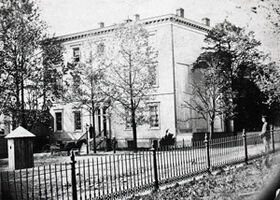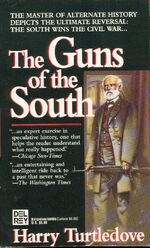
Situated on a hill overlooking Shockoe Valley in Richmond, Virginia's historic Court End neighborhood, the White House of the Confederacy was the official residence of the first and only President of the Confederate States, Jefferson Davis, and his family, during the American Civil War. After the war, the building served as the headquarters for Military District Number One, and was occasionally used as the residence of the commanding officer of the Department of Virginia. In 1870, the City of Richmond retook possession of the house, and subsequently used it as Richmond Central School, one of the first public schools in postwar Richmond.
On February 22, 1896, the mansion became the Museum of the Confederacy in order to prevent it from being demolished.
White House of the Confederacy in The Guns of the South[]
Public access to the Presidential mansion in Richmond was loose and easy during Jefferson Davis' presidency (1861-1868). Following the Rivington Men's attempt to kill President Robert E. Lee at his inauguration on March 4, 1868, security was increased in the form of AK-47-wielding guards, making the mansion seem to Lee like a fortress or a prison. After all the terrorists were killed or captured at the battle of Rivington later that month, this was loosened somewhat. Fortnightly levees were once again being held at the mansion by June.
White House of the Confederacy in Southern Victory[]
When Virginia seceded from the Union in 1861, Richmond was chosen as the nation's capital, the city rented the Brockenbrough House to the Confederate government as its Executive Mansion. After the war ended in 1862, it became the home to all Confederate Presidents. In the years following, it was referred to as the Gray House by the Confederacy, because of its relation to the White House in Washington, DC.
During the Great War, towards the end of 1916, the Gray House came under direct attack by the US when bombers were finally within range of the city, forcing the CS Army to install anti-aircraft guns on the mansion's grounds. While the grounds were hit with bombs and the windows were covered over with wooden boards, the mansion never received any serious damage and remained pretty much in order when the war ended.
When the Second Great War began in 1941, the US Army Air Corps attempted to bomb the mansion many times, but hardly enough to force C.S. President Jake Featherston to move his office. In 1942, a C.S. bombing raid unintentionally killed U.S. President Al Smith. who was at residence in the Powel House. Enraged, the US Army Air Corps launched a massive coordinated bombing raid in an attempt to kill the C.S. President in retaliation. Overwhelming the CS screening force, a squadron of dive bombers were able to completely destroy the mansion. However, Featherston and his staff had immediately evacuated the Gray House on hearing of Smith's death and were not harmed in the air raid.
After this raid, the Gray House was never repaired and left in ruin. When the US Army captured the city in 1944, they made no plans to rebuild it.
References[]
| |||||||||||||||||||











